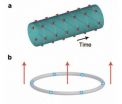(Press-News.org) CLEVELAND, Ohio (September 21, 2012)—Women treated for breast cancer after menopause with aromatase inhibitors have very high levels of sexual difficulties, including low interest, insufficient lubrication, and pain with intercourse. It is an important and underestimated problem, say the authors of a study published online in Menopause, the journal of the North American Menopause Society.
The researchers from Örebro University and Uppsala University in Sweden are the first to look at the impact of this type of breast cancer treatment on specific aspects of sexuality in postmenopausal women. Nearly three quarters of these women had insufficient lubrication, more than half (56%) had pain with intercourse, half said their sexual interest was low, and 42% were dissatisfied with their sex life, the study revealed. These percentages were far higher than for postmenopausal women who were not being treated for breast cancer. And although women taking tamoxifen for breast cancer also had low sexual interest and more pain with intercourse, they had significantly fewer difficulties than women taking aromatase inhibitors.
Aromatase inhibitors, which block formation of estrogen from other hormones in the body, may offer advantages in terms of preventing breast cancer recurrence and possibly in increasing survival, so they may be used more in the future. Unfortunately, effective treatment options for their sexual side effects are lacking, because too much estrogen may be absorbed from vaginal estrogen treatments, the authors pointed out. They called for more intensive study of the causes and impact of these side effects so we can improve breast cancer survivors' quality of life in the future.
The study will be published in the February 2013 print edition of Menopause.
###
Founded in 1989, The North American Menopause Society (NAMS) is North America's leading nonprofit organization dedicated to promoting the health and quality of life of all women during midlife and beyond through an understanding of menopause and healthy aging. Its multidisciplinary membership of 2,000 leaders in the field—including clinical and basic science experts from medicine, nursing, sociology, psychology, nutrition, anthropology, epidemiology, pharmacy, and education—makes NAMS uniquely qualified to serve as the definitive resource for health professionals and the public for accurate, unbiased information about menopause and healthy aging. To learn more about NAMS, visit our website: www.menopause.org
Contact:
The North American Menopause Society
Eileen Petridis
Phone: 216-696-0229
epetridis@fallscommunications.com
Breast cancer treatment brings sexual difficulties for postmenopausal women
2012-09-25
ELSE PRESS RELEASES FROM THIS DATE:
NASA's Chandra shows Milky Way is surrounded by halo of hot gas
2012-09-25
Astronomers have used NASA's Chandra X-ray Observatory to find evidence our Milky Way Galaxy is embedded in an enormous halo of hot gas that extends for hundreds of thousands of light years. The estimated mass of the halo is comparable to the mass of all the stars in the galaxy.
If the size and mass of this gas halo is confirmed, it also could be an explanation for what is known as the "missing baryon" problem for the galaxy.
Baryons are particles, such as protons and neutrons, that make up more than 99.9 percent of the mass of atoms found in the cosmos. Measurements ...
Melting Arctic ice cap at record
2012-09-25
Think of the poor hamster on the treadmill. Steadily picking up speed and caught up by the momentum, unable to stop until it is overwhelmed and sent tumbling, crashing out of control inside the spinning wheel.
That's the analogy John Yackel, head of the Department of Geography, makes when he considers the annual summer ice melt in the Arctic, which he's been closely monitoring for the past 15 years, documenting the ice cover as it has steadily shrunk in the wake of Arctic and global warming.
Last week marked the unofficial peak, or the end of the summer ice melt, ...
Automatic building mapping could help emergency responders
2012-09-25
CAMBRIDGE, MA -- MIT researchers have built a wearable sensor system that automatically creates a digital map of the environment through which the wearer is moving. The prototype system, described in a paper slated for the Intelligent Robots and Systems conference in Portugal next month, is envisioned as a tool to help emergency responders coordinate disaster response.
In experiments conducted on the MIT campus, a graduate student wearing the sensor system wandered the halls, and the sensors wirelessly relayed data to a laptop in a distant conference room. Observers in ...
A clock that will last forever
2012-09-25
Imagine a clock that will keep perfect time forever, even after the heat-death of the universe. This is the "wow" factor behind a device known as a "space-time crystal," a four-dimensional crystal that has periodic structure in time as well as space. However, there are also practical and important scientific reasons for constructing a space-time crystal. With such a 4D crystal, scientists would have a new and more effective means by which to study how complex physical properties and behaviors emerge from the collective interactions of large numbers of individual particles, ...
Viruses help MU scientists battle pathogenic bacteria and improve water supply
2012-09-25
Infectious bacteria received a taste of their own medicine from University of Missouri researchers who used viruses to infect and kill colonies of Pseudomonas aeruginosa, common disease-causing bacteria. The viruses, known as bacteriophages, could be used to efficiently sanitize water treatment facilities and may aid in the fight against deadly antibiotic-resistant bacteria.
"Our experiment was the first to use bacteriophages in conjunction with chlorine to destroy biofilms, which are layers of bacteria growing on a solid surface," said Zhiqiang Hu, associate professor ...
First-ever treatment for rare childhood aging disease shows improvement in all trial participants
2012-09-25
BOSTON, MA (September 24, 2012) – Results of the first-ever clinical drug trial for children with Progeria, a rare, fatal "rapid-aging" disease, demonstrate the efficacy of a farnesyltransferase inhibitor (FTI), a drug originally developed to treat cancer. The clinical trial results, completed only six years after scientists identified the cause of Progeria, included significant improvements in weight gain, bone structure and, most importantly, the cardiovascular system, according to The Progeria Research Foundation (PRF) and Boston Children's Hospital. The study results ...
Florida State University chemist may hold key to building a better toxin mousetrap
2012-09-25
TALLAHASSEE, Fla. — A Florida State University chemist's work could lead to big improvements in our ability to detect and eliminate specific toxins in our environment.
Featured on the cover of the prestigious Journal of the American Chemical Society (JACS), Sourav Saha's specialized work to strip electrons from the toxic chemical known as fluoride is producing a variety of unique results.
"I started out with the very basic premise of trying to find new ways to detect toxic fluoride in solutions," said Saha, an assistant professor of chemistry at Florida State. "As ...
Treating ovarian cancer: New pathways through genetics
2012-09-25
This press release is available in French.Montreal, September 24, 2012 – A new discovery that sheds light on the genetic make up of ovarian cancer cells could explain why some women survive longer than others with this deadly disease. A multi-disciplinary team led by the Research Institute of the McGill University Health Centre (RI MUHC), in collaboration with the Lady Davis Institute of the Jewish General Hospital and the University of Montreal Hospital Research Centre, has identified genetic patterns in ovarian cancer tumours that help to differentiate patients based ...
Exposing cancer's lethal couriers
2012-09-25
Malignant cells that leave a primary tumor, travel the bloodstream and grow out of control in new locations cause the vast majority of cancer deaths. New nanotechnology developed at Case Western Reserve University detects these metastases in mouse models of breast cancer far earlier than current methods, a step toward earlier, life-saving diagnosis and treatment.
A team of scientists, engineers and students across five disciplines built nanochains that home in on metastases before they've grown into new tissues, and, through magnetic resonance imaging, detect their locations. ...
White matter, old dogs, and new tricks at Dartmouth
2012-09-25
Most people equate "gray matter" with the brain and its higher functions, such as sensation and perception, but this is only one part of the anatomical puzzle inside our heads. Another cerebral component is the white matter, which makes up about half the brain by volume and serves as the communications network.
The gray matter, with its densely packed nerve cell bodies, does the thinking, the computing, the decision-making. But projecting from these cell bodies are the axons—the network cables. They constitute the white matter. Its color derives from myelin--a fat that ...



